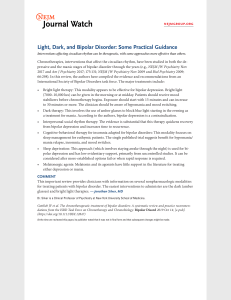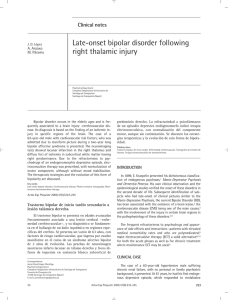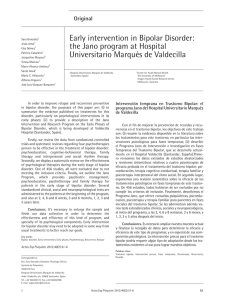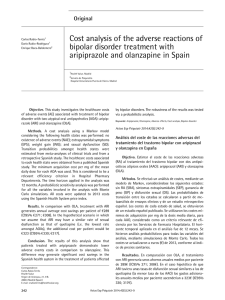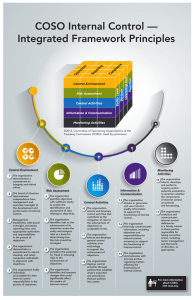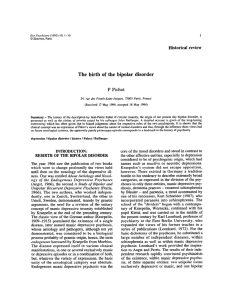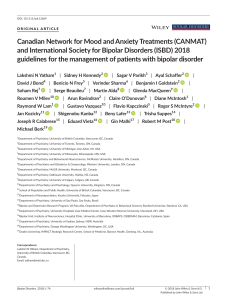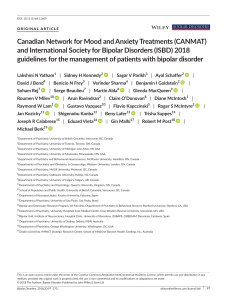Cognitive executive performance influences functional
Anuncio
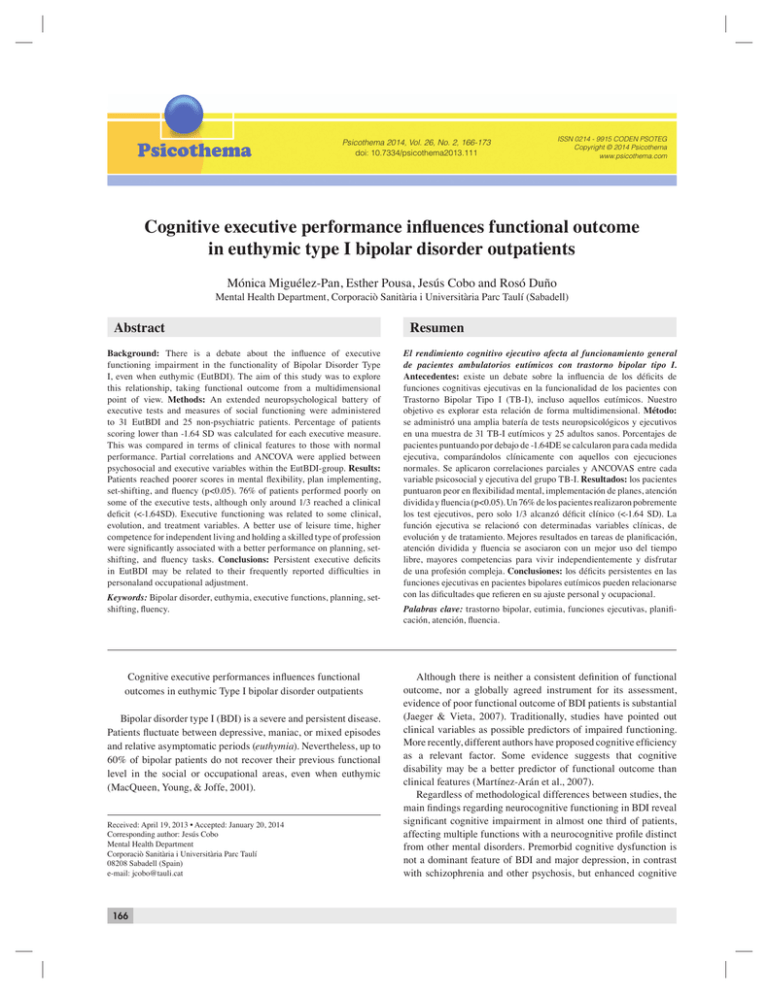
Mónica Miguélez-Pan, Esther Pousa, Jesús Cobo and Rosó Duño Psicothema 2014, Vol. 26, No. 2, 166-173 doi: 10.7334/psicothema2013.111 ISSN 0214 - 9915 CODEN PSOTEG Copyright © 2014 Psicothema www.psicothema.com Cognitive executive performance influences functional outcome in euthymic type I bipolar disorder outpatients Mónica Miguélez-Pan, Esther Pousa, Jesús Cobo and Rosó Duño Mental Health Department, Corporaciò Sanitària i Universitària Parc Taulí (Sabadell) Abstract Background: There is a debate about the influence of executive functioning impairment in the functionality of Bipolar Disorder Type I, even when euthymic (EutBDI). The aim of this study was to explore this relationship, taking functional outcome from a multidimensional point of view. Methods: An extended neuropsychological battery of executive tests and measures of social functioning were administered to 31 EutBDI and 25 non-psychiatric patients. Percentage of patients scoring lower than -1.64 SD was calculated for each executive measure. This was compared in terms of clinical features to those with normal performance. Partial correlations and ANCOVA were applied between psychosocial and executive variables within the EutBDI-group. Results: Patients reached poorer scores in mental flexibility, plan implementing, set-shifting, and fluency (p<0.05). 76% of patients performed poorly on some of the executive tests, although only around 1/3 reached a clinical deficit (<-1.64SD). Executive functioning was related to some clinical, evolution, and treatment variables. A better use of leisure time, higher competence for independent living and holding a skilled type of profession were significantly associated with a better performance on planning, setshifting, and fluency tasks. Conclusions: Persistent executive deficits in EutBDI may be related to their frequently reported difficulties in personaland occupational adjustment. Keywords: Bipolar disorder, euthymia, executive functions, planning, setshifting, fluency. Cognitive executive performances influences functional outcomes in euthymic Type I bipolar disorder outpatients Bipolar disorder type I (BDI) is a severe and persistent disease. Patients fluctuate between depressive, maniac, or mixed episodes and relative asymptomatic periods (euthymia). Nevertheless, up to 60% of bipolar patients do not recover their previous functional level in the social or occupational areas, even when euthymic (MacQueen, Young, & Joffe, 2001). Received: April 19, 2013 • Accepted: January 20, 2014 Corresponding author: Jesús Cobo Mental Health Department Corporaciò Sanitària i Universitària Parc Taulí 08208 Sabadell (Spain) e-mail: jcobo@tauli.cat 166 Resumen El rendimiento cognitivo ejecutivo afecta al funcionamiento general de pacientes ambulatorios eutímicos con trastorno bipolar tipo I. Antecedentes: existe un debate sobre la influencia de los déficits de funciones cognitivas ejecutivas en la funcionalidad de los pacientes con Trastorno Bipolar Tipo I (TB-I), incluso aquellos eutímicos. Nuestro objetivo es explorar esta relación de forma multidimensional. Método: se administró una amplia batería de tests neuropsicológicos y ejecutivos en una muestra de 31 TB-I eutímicos y 25 adultos sanos. Porcentajes de pacientes puntuando por debajo de -1.64DE se calcularon para cada medida ejecutiva, comparándolos clínicamente con aquellos con ejecuciones normales. Se aplicaron correlaciones parciales y ANCOVAS entre cada variable psicosocial y ejecutiva del grupo TB-I. Resultados: los pacientes puntuaron peor en flexibilidad mental, implementación de planes, atención dividida y fluencia (p<0.05). Un 76% de los pacientes realizaron pobremente los test ejecutivos, pero solo 1/3 alcanzó déficit clínico (<-1.64 SD). La función ejecutiva se relacionó con determinadas variables clínicas, de evolución y de tratamiento. Mejores resultados en tareas de planificación, atención dividida y fluencia se asociaron con un mejor uso del tiempo libre, mayores competencias para vivir independientemente y disfrutar de una profesión compleja. Conclusiones: los déficits persistentes en las funciones ejecutivas en pacientes bipolares eutímicos pueden relacionarse con las dificultades que refieren en su ajuste personal y ocupacional. Palabras clave: trastorno bipolar, eutimia, funciones ejecutivas, planificación, atención, fluencia. Although there is neither a consistent definition of functional outcome, nor a globally agreed instrument for its assessment, evidence of poor functional outcome of BDI patients is substantial (Jaeger & Vieta, 2007). Traditionally, studies have pointed out clinical variables as possible predictors of impaired functioning. More recently, different authors have proposed cognitive efficiency as a relevant factor. Some evidence suggests that cognitive disability may be a better predictor of functional outcome than clinical features (Martínez-Arán et al., 2007). Regardless of methodological differences between studies, the main findings regarding neurocognitive functioning in BDI reveal significant cognitive impairment in almost one third of patients, affecting multiple functions with a neurocognitive profile distinct from other mental disorders. Premorbid cognitive dysfunction is not a dominant feature of BDI and major depression, in contrast with schizophrenia and other psychosis, but enhanced cognitive Cognitive executive performance influences functional outcome in euthymic type I bipolar disorder outpatients function may be a risk marker for BDI. After the onset of the illness, most of the studies detected cognitive impairments in information processing speed, verbal learning and memory, and response inhibition. Most patients present a tendency to stability of the deficits, but there is an increased risk of dementia in their old ages. In a great proportion of BDI patients, the presence of cognitive impairment is the best future predictor of functional outcomes (Kumar & Frangou, 2010). Regarding euthymia, reviews on cognitive status of euthymic patients have reported a lower performance in attention, learning and verbal memory, psychomotor speed, visuospatial abilities, and executive functions (Malhi, Ivanovski, Szekeres, & Olley, 2004; Martínez-Arán, Godwin, & Vieta, 2001; Murphy & Sahakian, 2001; Robinson, Thompson, Gallagher, Goswami, Young et al., 2006; Savitz, Solms, & Ramesar, 2005). Many studies provide evidence of poor performance in mental flexibility, abstraction, set-shifting, working memory, inhibition, and verbal fluency (Malhi et al., 2004; Olley, Malhi, Mithcell, Batchelor, Lagopoulos et al., 2005; Robinson et al., 2006). Meanwhile, planning, decision-making, and problem solving capabilities seem to be relatively preserved, albeit bipolar patients need increased time to complete tasks involving these functions (Olley et al., 2005). White matter abnormalities have also been found to be predictive of poor outcome (Bearden, Woogen, & Glahn, 2010; Forcada, Papachristou, Mur, Christodoulou, Jogia et al., 2011). In general, different studies have raised the need for formal assessment of cognition in patients with bipolar disorder (Martínez-Arán et al., 2001; Malhi et al., 2004; Savitz et al., 2005; Olley et al., 2005; Robinson et al., 2006). Executive functions include a broad range of mental abilities to respond adaptively to novel situations and are necessary for appropriate, socially responsible and effectively self-serving adult behaviour. In the last years, studies have been carried out regarding the association between cognitive impairment in stable BDI patients and their functional status. Different studies reported an association between memory deficits and poor functional status. In addition, global social and occupational functioning were found to be positively and moderately correlated with learning and attention inhibition abilities in euthymic patients (Atre-Vaidya et al., 1998; Zubieta, Huguelet, O’Neil, & Giordani, 2001; Trivedi et al., 2008). Martinez-Aran and her group found that overall functioning was related to verbal fluency performance, and global measures of functioning were related to some measures of frontal executive functioning and several memory processes (MartínezArán et al., 2002; Martínez-Arán et al., 2004a; Martínez-Arán et al., 2007). Sub depressive symptoms together with neurocognitive impairments related to verbal memory and executive functions or processing speed and verbal learning deficits were predictor variables of long-term functional outcome (Bonnin et al., 2010; Burdick, Goldberg, & Harrow, 2010). Cognitive dysfunction in BDI is more severe in patients with depressive symptoms, especially regarding processing speed and attention, so that the interpretation of cognitive functioning in patients with depressive symptoms should take this into account. Moreover, history of psychosis in bipolar patients may also explain part of the neurocognitive variance (Van der WerfEldering, Burger, Holthausen, Aleman, & Nolen, 2010; Simonsen et al., 2011). Functional outcome is a multi-dimensional concept and its complexity needs to be considered. Furthermore, in this specific population, it is relevant to assess different executive processes. A crucial point is also to consider the euthymic periods as target for research because of the relevance of functionality during these phases and the complexity of the evaluation of patients in acute phases or with prominent residual symptoms. The present study aims to determine the executive functioning profile of a highly selected sample of euthymic BDI outpatients and to explore the complex relationship between differentiated executive processes and multiple dimensions of functional outcome. We hypothesized that euthymic bipolar patients would show impairment in both executive abilities and functional status. Method Participants A cross-sectional descriptive study was carried out, assessing performance on executive functions and functional status in euthymic BDI outpatients. Fifty-nine subjects with a Diagnostic and Statistical Manual of Mental Disorders (DSM-IV, American Psychiatric Association, 1994) diagnosis of Type I Bipolar Disorder, confirmed through the Structured Clinical Interview for Diagnostic Symptoms for DSMIV (First, Spitzer, Gibbon, & Williams, 1997), in a euthymic state were selected to participate from either our Psychiatry Out-patient Clinic “Centre de Salut Mental - Corporació Sanitària Parc Taulí” and/or from our local Association for Bipolar and Depressed Persons “Associació de Bipolars i Depressius del Vallés”. Eighteen- to sixty-five-year-old patients were included. The study was approved by our Clinical and Ethics Research Committee. As in previous studies (Martínez-Arán et al., 2007), patients were considered euthymic if: (a) they presented at least 6 months of remission; (b) they scored < 8 on the Hamilton Depression Rating Scale, 17-items (HDRS-17, Spanish version; Ramos-Brieva, Vieta & Cordero-Villafafila, 1988); and (c) they scored <6 on the Young Mania Rating Scale (YMRS, Spanish version; Colom et al., 2002). Exclusion criteria were: presence of psychiatric comorbidity in either I or II DSM-IV-TR axes, presence of any acute organic illness, visual or auditory sensory disability, history of CNS disease, history of pre- or perinatal complications, developmental disabilities (including learning disabilities, dyslexia, stuttering, motor retardation, retarded language acquisition, and attention deficit disorder), presence of current drug abuse (except tobacco) or endocrine disorders (except for treated non-symptomatic hypoor hyperthyroidism). Participants showing low performance in language comprehension (scores < 30 in the Token Test) (De Renzi & Faglioni, 1978) and/or in attention verbal span (< 5 digits correctly repeated in the WAIS-III Digits Forward subtest; Wechsler, 1997) were also excluded. Only 34 of the patients selected finally agreed to participate. All of them provided written informed consent. Three of them did not entirely fulfill the inclusion criteria and were excluded. The final sample consisted of 31 patients (Table 1). Each patient underwent a clinical interview by an expert psychiatrist (JVC) during which sociodemographic, clinical and evolution characteristics were recorded. A battery of tests for the assessment of executive functions and premorbid IQ were administered by an expert neuropsychologist (MM). Functional status was 167 Mónica Miguélez-Pan, Esther Pousa, Jesús Cobo and Rosó Duño assessed by a clinical psychologist (EP). Finally, blood sample was taken in order to determine mood-stabilizer serum levels, as well as to control thyroid function. Time required to complete the entire evaluation was 90-120 minutes, including a 15-minute break. Treatment adherence was rated as a dichotomous variable (regular/irregular) according to the assessment of three aspects: level of attendance to the outpatients department, blood levels of pharmacological treatment and psychiatric interview with direct questions about adherence. A control group of 31 healthy subjects matched by gender, age and educational level, and belonging to the same population of reference was also recruited. Exclusion criteria were the same as those used for BDI outpatients, plus history of mental illness and/ or current psychiatric symptoms (Symptom Global Index SGI of > 0.6 on the Symptom Cheklist-90R, Spanish version; MartínezAzumendi, Fernández-Gómez, & Beitia-Fernández, 2001). Six subjects had to be excluded because they scored > 0.6 in the SGI, so the final control group comprised 25 healthy subjects. Preliminary analysis found no significant differences in age, gender or educational levels between patient and control groups. Instruments Clinical variables The following clinical variables were obtained from patients: Current clinical status as assessed by the HDRS-17 and the YMRS; psychiatric history (chronicity of illness in years, number of mania episodes, number of depression episodes, number of hospitalizations, history of self-injury episodes, treatment adherence); and current pharmacological treatment (type and doses of antidepressants, antipsychotics, mood stabilizers, benzodiazepines, and blood levels of mood stabilizers). As for the control group, the Spanish version of the Symptom Checklist 90-R was administered and the SGI index calculated. The Spanish version of the Hamilton Depression Rating Scale, 17-items (Ramos-Brieva, Vieta, & Cordero-Villafafila, 1988) has good concurrent (r = .82) and content (average frequency = 62%) validity. Inter-rater reliability (r = .99), split-half reliability (r = .89) and alpha reliability (r = .72) are acceptable. The Spanish version of the Young Mania Rating Scale (Colom et al., 2002) showed a reliability index of .88 (internal consistency) and 0.76 (test-retest reliability), and good internal and external validity (p<.001). The results also showed good sensitivity and feasibility. The 36-item-version of the Token Test (De Renzi & Faglioni, 1978) has been found to be sensitive in detecting impairment of oral comprehension. The cutting point of scores at < 30 in language comprehension was obtained from the original data. The SGI (Symptom Global Index) of the Spanish version of the Symptom Cheklist-90R (Martínez-Azumendi, FernándezGómez, & Beitia-Fernández, 2001) was obtained. This tool is a good measure for global distress and the proposed cut-off point of > 0.6 is an easy way to detect significant psychopathology. Neuropsychological variables: – Attention verbal span (WAIS-III Digits Forward). – Oral comprehension (Token Test, TT). – Estimated premorbid IQ (WAIS-III Vocabulary subtest). 168 – Mental flexibility (Wisconsin Card Sorting Test-64, WCST64; Kongs, Thompson, Iverson, & Heaton, 2000). – Concept formation-abstraction (WAIS-III Similarities subtest). – Set-shifting (Trail Making Test, TMT, parts A and B: Reitan & Wolfson, 1985). – Planning (Tower of London-Drexel University, ToL; Culbertson & Zilmer, 2000). – Verbal fluency (FAS; Benton & Hamsher, 1976). – Non-verbal fluency (Five Point Test, 5PT; Regard, Strauss, & Knapp, 1982). – Inhibition control (Stroop Color and Word Test; Golden, 1978). – Working memory (WAIS-III Digits Backward subtest). – Dysexecutive syndrome severity (Frontal Assessment Battery, FAB; Dubois, Stachevsdy, Litvan, & Pillon, 2000). Direct scores of each test were used for data analysis Functional status Global Assessment of Functioning (GAF; Endicott, Spitzer, Fleix & Cohen, 1976) and the self-reported version of the Social Functioning Scale (SFS), Spanish version (Vázquez-Morejón & Jiménez, 2000) were administered to participants. Specific sociodemographic information was considered as ecological indicators of functional outcome: marital status, living situation, type of profession, current employment situation, seniority in the current job position, and time unemployed (in months). The GAF is a rating scale for evaluating the overall functioning of a subject during a specified time period on a continuum from psychological or psychiatric sickness to health. The GAF was found to have good reliability. GAF ratings were found to have a greater sensitivity to change over time than did other ratings of overall severity or specific symptom dimensions. The self-reported version of the Social Functioning Scale (SFS; Birchwood et al., 1990), Spanish version (Vázquez-Morejón & Jiménez, 2000) was administered to participants. The SFS is specifically designed to assess the most relevant areas of social functioning in schizophrenia and other severe psychiatric disorders. It covers seven areas: withdrawal, interpersonal behaviour, prosocial activities, recreation, independence- performance, independence-competence and employment/occupation. The study of the reliability and validity of the scale revealed a substantial fulfillment of the basic psychometric criteria (Vázquez Morejón & Jiménez, 2000). Data analysis Statistical analysis was carried out using the SPSS 12.0.1 statistical software. First, data were examined to determine whether they adjusted to normal distribution. Then, a descriptive analysis was carried out, expressing the results for parametric variables as mean and standard deviation, and in the form of mean, SD and quartiles for non-parametric variables. Qualitative measures were expressed in percentages. BDI and control groups were compared on demographic characteristics, using the Student’s t test, Mann-Whitney U test or Chi-square, as appropriate. Comparison tests for independent Cognitive executive performance influences functional outcome in euthymic type I bipolar disorder outpatients samples were carried out to compare premorbid IQ, verbal comprehension, attention span, executive performance and functional measures. With the aim of determining clinically significant impairment in executive functions, scores of the bipolar group were transformed into standard scores according to the mean and SD obtained in the control group, following a procedure described previously (Tohen et al., 2000). Then, the percentage of patients whose standard score fell below 16th and 5th percentiles (-1SD and -1.64SD from control’s mean, respectively) was calculated for each measure. The relationship between performance on executive tests and functional outcome in the bipolar group was examined using partial correlational analysis for quantitative variables and ANCOVAs for discrete variables, controlling for age, education, IQ and equivalent doses of haloperidol and diazepam (Expert Consensus Panel for Optimizing Pharmacologic Treatment of Psychotic Disorders, 2003; Preston, O’Neal, & Talaga, 2005). In order to reduce the number of correlations, only the measures reflecting significant impairment in patients were examined. Significance for all analyses was set at a confidence level of 95%. For multiple comparisons the Bonferroni correction was used. Results Sample description and functional status comparison between BDI outpatients and controls Table 1 shows sociodemographic, functional and general cognitive characteristics of BDI and control subjects, as well as comparisons between groups. No significant differences were found regarding age, sex, education, estimated premorbid IQ, verbal comprehension, or attention span. Significant group differences were found in most functional status variables. Table 1 Sociodemographic, functional and overall cognitive characteristics of bipolar and control groups BDI -group (n = 31) Control group (n = 25) statistic p 18:13 41.3(11.18) 10.74(3.57) 96.7:3.3 15:10 40.40(9.72) 11.12(4.24) 84.0:16.0 Chi = 0.021 t = 0.325 t = -0.362 Chi = 1.92 1,00 0.746 0.719 0.392 Functional status Marital status (%) No partner Stable partner 54.8 45.2 24.0 76.0 Chi = 6.51 0.016 Living situation (%) Independent from parents Living with parents 61.3 38.7 80.0 20.0 Chi = 3.07 0.095 Employment situation (%) Employed Unemployed 32.3 67.8 68.0 32.0 Chi = 5.52 0.034 Type of profession (%) Skilled job Unskilled job 67.7 32.3 100.0 0.0 Chi = 11.03 0.001 Seniority in current job (months) (mean,SD) 68.2(95.4) (n = 11) 175.2(120.6) (n = 15) U = 29.0 0.005 Time unemployed since last job (months) (mean,SD) 25.6(33.0) (n = 13) 61.5(50.6) (n = 6) U = 23.0 0.160 GAF (mean,SD) 74.1(9.37) 97.3(3.8) t = -12.77 <0.001 Social Functioning Scale (SFS) (mean,SD) Social engagement/Withdrawal (SE/W) Interpersonal behaviour (I) Pro-social activities (PRO) Recreation (R) Independence-Competence (IC) Independence-Performance (IP) Employment/Occupation (E/O) Total Social Functioning (SFS-tot) [1-7] 11.93(1.93) 7.45(1.61) 22.3(10.3) 18.9(6.21) 35.7(4.0) 24.8(6.3) 6.5(3.1) 4.59(0.70) 13.22(0.85) 8.78(0.42) 19.78(8.33) 22.17(7.63) 38.30(1.22) 26.87(5.74) 8.78(2.13) 5.20(0.42) t = -3.29 t = -4.41 t = 0.983 t = -1.75 t = -3.43 t = -1.24 t = -3.13 t = -3.99 0.002 <0.001 0.330 0.086 0.001 0.220 0.003 <0.001 General cognitive abilities (mean,SD) Digits forward (Number of elements of the longest correct item) Token-Test Estimated premorbid-IQ 5.54(0.85) 33.92(1.24) 98.9(10.3) 5.92(0.86) 34.08(0.91) 100.8(11.6) U = 287.0 t = -1.56 t = -0.658 0.179 0.359 0.513 Variable Sociodemographic characteristics Gender (men:women), (n) Age (mean;SD) Years of education (mean;SD) Hand dominance (right:left)(%) 169 Mónica Miguélez-Pan, Esther Pousa, Jesús Cobo and Rosó Duño Clinical features of BDI patients are shown in Table 2. All the patients in our sample were stabilized, on effective treatment and were good compliers with treatment and visits for years. Executive functioning Performance of BDI patients and controls in the executive tests is shown in Table 3. Percentages of patients with scores below the 16th and 5th percentiles are also specified. Significant differences between patient and control groups were revealed in different executive functioning tasks. After Bonferroni correction, only the Dysexecutive Syndrome Severity reached significance. The possible effect of clinical variables on executive scores was analyzed in the bipolar group. For this purpose, the bipolar group was split into two subgroups for each neuropsychological measure, differentiating patients scoring below –1SD. In each case, subgroups were compared on residual affective symptoms, evolution characteristics and treatment measures through Mann-Whitney U test and ANCOVA. Some clinical variables significantly influenced the scores reached in the ToL and WCST Table 2 Clinical characteristics of bipolar disorder I type (BDI) group mean(SD) [%] Diagnosis (DSM-IV) BDI, most recent single manic episode BDI, most recent episode manic/hypomanic BDI, most recent episode depressed BDI, most recent episode mixed BDI, most recent episode unspecified range[minmax] [6.4] [22.6] [19.3] [3.2] [48.4] Residual mood symptoms Depression (HDRS) Mania (YMRS) 3.84(2.42) 2.26(1.96) 0-7 0-5 Current GAF score 74.1(9.37) 55-90 Disorder features: Age at BDI onset Chronicity (years) Number of hospitalizations (n = 24) Number of depressed episodes Number of manic episodes Months since last episode Suicide attempts (Yes:No) 27.6(10.0) 13.4(9.03) 2.04(1.27) 3.75(2.67) 3.25(1.80) 32.6(35.8) [35.5:64.5] 15-46 2-39 0-5 0-10 1-8 6-149 Current pharmacological treatment Mood stabilizer(s) Lithium Valproate Others (oxcarbamazepine, carbamazepine, topiramate) None Mood stabilizer blood level % in therapeutic range % below therapeutic range % above therapeutic range Antidepressants Benzodiazepines Diazepam equivalent Dose (mg/day) (n = 19)(mean,SD) Antipsychotics Haloperidol equivalent dose (mg/day) (n = 14)(mean,SD) Treatment adherence (regular:irregular) 170 [96.8] [58.1] [22.6] [16.2] Relationships between executive performance and functional status in BDI patients Executive functioning measures showed some significant relationships and between-group differences with scores on the SFS and GAF scales. Poor functional status regarding recreation and independent living were significantly associated with lower performance on planning and verbal and non-verbal fluency (p<.05). Recreation (SFS) was correlated to ToL execution time (r = -.397, p = .049), ToL Time violation (r = -.472, p = .017) and Graphic fluency 5-point test (r = .475, p = .014). IndependenceCompetence (SFS) was correlated to FAS-total (r = .533, p = .005). Regarding qualitative measures of functional outcome, marital status and profession were found to be significantly associated with executive measures. Patients with a stable partner showed a worse performance on the TMT-B than those without (mean = 144.57 versus 87.06, F = 5.18, p = 0.032), and patients holding a skilled job showed a better performance that those with an unskilled job on the TMT-B (mean = 93.00 versus 155.10, F = 7.34, p = 0.012) and ToL-Execution time (mean = 245.30 versus 387.00, F = 5.35, p = 0.030). Living situation and employment status were not significantly related with any of the executive measures (all ps>.05). None of the global functioning measures (GAF and SFS-total scores) was significantly related to performance on any of the executive functioning tasks (p>.05). Discussion Functional status [3.1] [73.1] [23.1] [3.8] [35.5] [58.1] 13.68(11.12) 1.25 - 50.0 [41.9] 2.71(2.17) 0.42 - 8.5 [75.0:25.0] tests: patients with ToL-Latency, ToL-Time violation and ToLRule violation scores lower than 16th percentile also obtained lower scores on YMRS (mean = 0.00 versus 2.50, U = 9.00, p = .026), took higher haloperidol equivalent dose (mean = 4.18 versus 2.00, U = 38.50, p = .025), and their illness evolution was longer (mean = 17.50 versus 9.87 years, U = 57.50, p = .022), respectively. Effects of age at BDI onset on ToL-Total Movement score (mean = 34.50 versus 26.00 years, U = 36.50, p = .054), effects of YMRS score on both ToL-Total time violation score (mean = 1.00 versus 2.65, U = 44.00, p = .053) and FAS-Total score (mean = 1.45 versus 2.70, U = 65.50, P = 0.061), as well as effects of chronicity of illness on Digits Backward Total Score (mean = 17.20 versus 11.62, U = 59.00, p = 0.052), and effects of current benzodiazepine dose on FAS-Repetition score (mean = 10.09 versus 3.75, U = 61.50, p = 0.052) were close to statistical significance. No other effects of clinical variables on executive performance were found. Comparison of functional outcome between patients and controls showed significant differences regarding marital and employment status, type of profession, seniority in current job, and most SFS scores, with patients showing a lower adjustment. These results are in line with previous findings revealing that functional impairment mainly affects the job and social-affective domains (Coryell et al., 1998). However, no differences were found regarding global functioning as measured by the GAF, suggesting that global measures may not provide a reliable picture of patients’ functioning. Cognitive executive performance influences functional outcome in euthymic type I bipolar disorder outpatients Table 3 Performance in executive tests: group comparisons and percentage of patients below the 16th and 5th percentiles compared to controls Patients (%) below BDI group (n = 31) Control group (n = 25) m(SD) m(SD) 5.41(1.72) 4.19(1.08) [3;4;5] 5.92(1.75) 4.48(0.96) [4;4;5] t = -1.07 U = 310.0 ns ns Set-shifting TMT B TMT B-A 113.03(58.8) 69.78(49.6) 83.92(36.86) 49.00(33.59) t = 2.26 t = 1.79 Mental flexibility WCST total errors WCST perseverative responses WCST completed categories 25.35(10.4) 17.84(14.7) 2.26(1.44) 19.72(8.78) 10.64(5.01) 3.08(1.38) Abstraction Similarities scaled score 9.97(3.57) Measure Statistic p P* 16th percentile 5th percentile ns ns 32.3 25.8 9.7 0.028 ns ns ns 32.3 29.0 32.3 29.0 t = 2.16 t = 2.54 t = -2.16 0.035 0.015 0.035 ns ns ns 38.7 38.7 38.7 22.6 35.5 6.5 10.96(2.23) t = -1.80 ns ns 23.3 10.0 35.17(25.4) 64.7(42.3) 292.5(146.9) 1.03(1.69) [0;0;1] 1.53(1.52) [0.75;1;2] 32.56(17.51) 70.40(46.19) 221.12(76.26) 0.44(0.65) [0;0;1] 0.68(0.99) [0;0;1] t = 0.43 t = -0.48 t = 2.31 U = 318 ns ns 0.025 ns ns ns ns ns 20.0 10.0 40.0 46.7 10.0 0.0 23.3 U = 231.5 0.011 ns 76.7 31.2(10.0) 0.68(1.33) [0;0;1] 37.08(9.67) 0.84(1.80) [0;0;1] t = -2.21 U = 345.5 0.031 ns ns ns 35.5 22.3 16.1 33.52(11.18) 88.10(13.46) 32.88(11.7) 94.69(6.46) t = 0.21 t = -2.41 ns 0.020 ns ns 12.9 35.5 6.5 22.6 Inhibition control Stroop Interference 1.62(8.21) 1.60(7.01) t = 0.011 ns ns 16.1 0.0 Dysexecutive Syndrome Severity FAB 16.3(1.40) 17.25(0.85) t = -3.04 0.004 0.004 48.4 22.6 Working memory Digits Backward Total Digits Backward Longest correct serie(¹) Planning ToL total movements ToL latency ToL execution time ToL rule violation(¹) ToL time violation(¹) Generativity-Fluency Verbal fluency FAS total FAS perseverations (¹) Graphic fluency 5-point test total designs 5-point test % unique designs (1) Quartiles are also shown. ns: non significative. P*: p after Bonferroni correction (p>0.00625) Executive functioning Confirming one of our initial hypotheses, patients tended to score lower than controls in all executive measures. However, statistical significance was reached for some –but not all– of the administered executive tests. Poor performance was significantly evidenced in tasks involving set-shifting, verbal and non-verbal fluency, and mental flexibility. Slowing in plan implementing was also revealed. These results support previous evidence. Furthermore, clinical variables showed little effect on executive performance, corroborating that the executive deficit is independent from both the presence of residual symptoms or treatment characteristics (Ferrier, Stanton, Kelly, & Scott, 1999; Martínez-Arán et al., 2001; Murphy & Sahakian, 2001; Martínez-Arán et al., 2002; Malhi et al., 2004; Savitz et al., 2005; Osuji & Callum, 2005). In contrast with previous studies, the present research included a broad assessment of different executive processes. This revealed the heterogeneity of the executive functioning components in BDI euthymic patients, with poor efficiency of some processes and relative preservation of others (Robinson et al., 2006). When focusing on each executive process, our results are in line with previous reports of poor performance of euthymic BDI patients in mental flexibility (Zubieta et al., 2001; MartínezArán et al., 2002; Martínez-Arán et al., 2004a; Martínez-Arán et al., 2004b), verbal fluency (Atre-Vaidya et al., 1998; Ferrier et al., 1999), and set-shifting (Tham et al., 1995; Ferrier et al., 1999; Martínez-Arán et al., 2004a). Non-verbal fluency, which is rarely included in executive assessment, was also impaired in our sample (Goswami et al., 2006). Inhibition (Tham et al., 1995; Bearden, Hoffman, & Cannon, 2001; Cavanagh, Van Beck, Muir, & Blackwood, 2002; Martínez-Arán et al., 2002; Martínez-Arán et al., 2004a) and abstraction (Goswami et al., 2006) remained preserved in coherence with earlier reports. Patients did not differ from controls in solving planning tasks, in line with most 171 Mónica Miguélez-Pan, Esther Pousa, Jesús Cobo and Rosó Duño (Rubinsztein, Michael, Paykel, & Sahakian, 2000; Cavanagh et al., 2002; Clark, Iversen, & Goodwin, 2002), but not all, findings in the literature (Thompson et al., 2005). In spite of the above-mentioned unimpaired performance on most planning tasks, patients in the present study needed longer time to complete these tasks. This could be explained by either a genuine planning deficit or difficulties in mental processes other than planning (Olley et al., 2005). The role of pharmacological agents was also controlled. With regards to working memory, performance was not impaired in our patients, in contrast with other studies. Although working memory scores were not influenced by clinical variables in our study, sample differences in clinical severity could explain this divergence (Clark et al., 2002; Martínez-Arán et al., 2004a; Martínez-Arán et al., 2004b). In summary, different executive functions were not equally impaired in stable BDI, with a resulting profile of executive dysfunction that shares some characteristics with the dysexecutive syndrome and related abnormalities (Savitz et al., 2005; Goswami et al., 2006). Relationship between functional status and executive performance Certain executive measures were significantly associated with some functional variables related to job and independent living. Indeed, a significant association between some functional domains and performance on the executive dimensions of planning, set-shifting and fluency was obtained, even when controlling for age, education, IQ and dose of treatment. Thus, the poorer the performance showed in the tests assessing those abilities, the lower the engagement in recreation activities, the lower the competence in independent living and the less skilled the job held, in agreement with previous reports (Zubieta et al., 2001). In contrast, the relationship obtained between marital status and executive performance was unexpected. We believe that this finding might be due to the fact that marital status may be determined by multiple factors. Sociological, cultural and legal aspects may be relevant. Opposite to previous results, no significant relationships were found between any of the cognitive measures and global functioning indices (Martínez-Arán et al., 2002; Martínez-Arán et al., 2004a; Martínez-Arán et al., 2007). This may be explained by sample differences and/or by the fact that in the present study the effects of IQ, age, education and medication were controlled. Our findings should be considered cautiously due to several limitations, primarily derived from the cross-sectional design, the sample size and the neuropsychological tests administered. Our results excluded subjects with comorbid Axis I or II disorders and this aspect limited the extension of the results. Assessment instruments raise some limitations, partly resolved by the inclusion of a non-psychiatric control group. Our analysis only included the evaluation of current treatments. As subjects had a long duration of illness, they had received several previous treatments which could be related to the present cognitive deficits. Furthermore, the use of tests with proved sensitivity to neurological injury in psychiatric populations implies some questions. In conclusion, the present study revealed that stable BDI patients presented mild deficits in particular components of executive functioning (mental flexibility, verbal- and non-verbal fluency, set-shifting and planning). It also showed that these deficits were associated with a lower functional status, similar to some neurological patients, indicating that some of the functional complaints often reported by bipolar patients might derive from their executive neuropsychological impairment. Thus, the so-called “euthymia” in bipolar disorder does not imply patient’s total recovery. Besides possible residual affective symptoms, persistent deficits in planning and other actiondirecting components of executive ability may be behind some of their frequent functional, occupational and social difficulties. All these data have important clinical and therapeutically critical implications. Combined assessment of functional outcome, affective symptoms and cognitive profile might offer clinicians a more complete picture of bipolar patients and their impact in day-to-day functioning. It might also allow prediction of patients’ functioning level, as well as definition of a therapeutic plan fostering their future reinsertion within the community, improvement of their quality of life and reduction of healthcare costs through relapse prevention. References Atre-Vaidya, N., Taylor, M.A., Seidenberg, M., Reed, R., Perrine, A., & Glick-Oberwise, F. (1998). Cognitive deficits, psychopathology, and psychosocial functioning in bipolar mood disorder. Neuropsychiatry, Neuropsychology, and Behavioural Neurology, 11, 120-126. Bearden, C.E., Hoffman, K.M., & Cannon, T.D. (2001). The neuropsychology and neuroanatomy of bipolar affective disorder: A critical review. Bipolar Disorders, 3, 106-150. Bearden, C.E., Woogen, M., & Glahn, D.C. (2010). Neurocognitive and neuroimaging predictors of clinical outcome in bipolar disorder. Current Psychiatry Reports, 12, 499-504. Birchwood, M., Smith, J., Cochrane, R., Wetton, S., & Copestake, S. (1990). The Social Functioning Scale. The development and validation of a new scale of social adjustement for use in family intervention programs with schizophrenic patients. British Journal of Psychiatry, 157, 853-859. Benton, A.L., & Hamsher, K. (1976). Multilingual Aphasia Examination. Iowa City, IA: University of Iowa. Bonnín, C.M., Martínez-Arán, A., Torrent, C., Pacchiarotti, I., Rosa, A.R., Franco, C.,... Vieta, E. (2010). Clinical and neurocognitive predictors 172 of functional outcome in bipolar euthymic patients: A long-term follow-up study. Journal of Affective Disorders, 121, 156-160. Burdick, K.E., Goldberg, J.F., & Harrow, M. (2010). Neurocognitive dysfunction and psychosocial outcome in patients with bipolar disorder at 15-year follow-up. Acta Psychiatrica Scandinavica, 122, 499-506. Cavanagh, J.T., Van Beck, M., Muir, W., & Blackwood, D.H. (2002). Case-control study of neurocognitive function in euthymic patients with bipolar disorder: An association with mania. British Journal of Psychiatry, 180, 320-326. Clark, L., Iversen, S.D., & Goodwin, G.M. (2002). Sustained attention deficit in bipolar disorder. British Journal of Psychiatry, 180, 313319. Colom, F., Vieta, E., Martínez-Arán, A., García-García, M., Reinares, M., Torrent, C., ... Salamero, M. (2002). Versión española de una escala de evaluación de la manía: validez y fiabilidad de la Escala Young [Spanish version of a Scale for the evaluation of mania: Validity and reliability of the Young Scale]. Medicina Clínica, 119, 366-371. Cognitive executive performance influences functional outcome in euthymic type I bipolar disorder outpatients Coryell, W., Turvey, C., Endicott, J., Leon, A.C., Mueller, T., Solomon, D., & Keller, M. (1998). Bipolar I affective disorders: Predictors of outcome after 15 years. Journal of Affective Disorders, 50, 109-116. Culbertson, W.C., & Zilmer, E.A. (2000). Tower of London-Drexel University (TOLDX). North Tonawanda, NY: Multi-Health Systems. De Renzi, E., & Faglioni, P. (1978). Normative data and screening power of a shortened version of the Token Test. Cortex, 14, 627-630. Dubois, B., Stachevsdy, A., Litvan, I., & Pillon, B. (2000). The FAB. A frontal assessment battery at bedside. Neurology, 55, 1621-1626. Endicott, J., Spitzer, R.L., Fleix, J.L., & Cohen, J. (1976). The global Assessment Scale: A procedure for measuring overall severity of psychiatric disturbance. Archives of General Psychiatry, 33, 766771. Expert Consensus Panel for Optimizing Pharmacologic Treatment of Psychotic Disorders (2003). The Expert Consensus Guideline Series. Optimizing pharmacologic treatment of psychotic disorders. Journal of Clinical Psychiatry, 64(Suppl. 12), S2-S97. Ferrier, I.N., Stanton, B.R., Kelly, T.P., & Scott, J. (1999). Neuropsychological function in euthymic patients with bipolar disorder. British Journal of Psychiatry, 175, 246-251. First, M.B., Spitzer, R.L., Gibbon, M., & Williams, J.B.W. (1997). Structured clinical interview for DSM-IV (SCID) axis I disorders. Washington, DC: American Psychiatric Press. Forcada, I., Papachristou, E., Mur, M., Christodoulou, T., Jogia, J., Reichenberg, A.,... Frangou, S. (2011). The impact of general intellectual ability and white matter volume on the functional outcome of patients with Bipolar Disorder and their relatives. Journal of Affective Disorders, 130, 413-420. Golden, C.J. (1978). Stroop Color and Word Test: A manual for Clinical and experimental uses. Wood Dale, IL: Stoelting Co. Goswami, U., Sharma, A., Khastigir, U., Ferrier, I.N., Young, A.H., Gallagher, P., ... Moore, P.B. (2006). Neuropsychological dysfunction, soft neurological signs and social disability in euthymic patients with bipolar disorder. British Journal of Psychiatry, 188, 366-373. Jaeger, J., & Vieta, E. (2007). Functional outcome and disability in bipolar disorder: Ongoing research and future directions. Bipolar Disorders, 9, 1-2. Kongs, S.K., Thompson, L.L., Iverson, G.L., & Heaton, R.K. (2000). Wisconsin Card Sorting Test-64 Card Version. WCST-64. Lutz, FL: PAR Psychological Assessment Resources. Kumar, C.T.S., & Frangou, S. (2010). Clinical implications of cognitive function in bipolar disorder. Therapeutic Advances in Chronic Diseases, 1, 85-93. MacQueen, G.L., Young, L.T., & Joffe, R.T. (2001). A review of psychosocial outcome in patients with bipolar disorder. Acta Psychiatrica Scandinavica, 103, 163-170. Malhi, G.S., Ivanovski, B., Szekeres, V., & Olley, A. (2004). Bipolar disorder: It’s all in your mind? The neuropsychological profile of a biological disorder. Canadian Journal of Psychiatry, 49, 813-819. Martínez-Arán, A., Godwin, G.M., & Vieta, E. (2001). El mito de la ausencia de deterioro cognitivo en el trastorno bipolar [The myth of the absence of cognitive impairment in bipolar disorders]. In E. Vieta (Ed.), Trastorno bipolar [Bipolar Disorders] (pp. 51-85). Madrid: Médica Panamericana. Martínez-Arán, A., Vieta, E., Colom, F., Reinares, M., Benabarre, A., Torrent, C.,... Salamero, M. (2002). Neuropsychological performance in depressed and euthymic bipolar patients. Neuropsychobiology, 46, S16-S21. Martínez-Arán, A., Vieta, E., Colom, F., Torrent, C., Sánchez-Moreno, J., Reinares, M.,... Salamero, M. (2004a). Cognitive impairment in euthymic bipolar patients: Implications for clinical and functional outcome. Bipolar Disorders, 6, 224-232. Martínez-Arán, A., Vieta, E., Reinares, M., Colom, F., Torrent, C., Sánchez-Moreno, J.,... Salamero, M. (2004b). Cognitive function across manic or hypomanic, depressed, and euthymic states in bipolar disorder. American Journal of Psychiatry, 161, 262-270. Martínez-Arán, A., Vieta, E., Torrent, C., Sánchez-Moreno, J., Goikolea, J. M., Salamero, M.,... Ayuso-Mateos, J.L. (2007). Functional outcome in bipolar disorder: The role of clinical and cognitive factors. Bipolar Disorders, 9, 103-113. Martínez-Azumendi, O., Fernández-Gómez, C., & Beitia-Fernández, M. (2001). Variabilidad factorial del SCL-90-R en una muestra psiquiátrica ambulatoria [Factorial variability of the SCL-90 in an psychiatric outpatients sample]. Actas Españolas de Psiquiatría, 29, 95-102. Murphy, F.C., & Sahakian, B.J. (2001). Neuropsychology of bipolar disorder. British Journal of Psychiatry, 178, S120-S127. Olley, A., Malhi, G.S., Mithcell, P.B., Batchelor, J., Lagopoulos, J., & Austin, M.V. (2005). When euthymia is just not good enough: The neuropsychology of Bipolar Disorder. Journal of Nervous and Mental Diseases, 193, 323-330. Osuji, I.J., & Callum, C.M. (2005). Cognition in Bipolar Disorder. Psychiatric Clinics of North America, 28, 427-441. Preston, J.D., O’Neal, J.H., & Talaga, M.C. (2005). Handbook of Clinical Psychopharmacology for Therapists (4th ed.). Oakland, CA: New Harbinger. Ramos-Brieva, J.A., Vieta, E., & Cordero-Villafafila, A. (1988). A new validation of the Hamilton Rating Scale for Depresion. Journal of Psychiatry Research, 22, 21-28. Regard, M., Strauss, E., & Knapp, P. (1982). Children’s production on verbal and non-verbal fluency task. Perceptual and Motor Skills, 55, 839-844. Reitan, R.M., & Wolfson, D. (1985). The Halstead-Reitan Neuropsychological Test Battery. Tucson, AZ: Clinical Neuropsychological Press. Robinson, L.F., Thompson, J.M., Gallagher, P., Goswami, U., Young, A. H., Ferrier, I.N., & Moore, P.B. (2006). A meta-analysis of cognitive deficits in euthymic patients with bipolar disorder. Journal of Affective Disorders, 93, 105-115. Rubinsztein, J.S., Michael, A., Paykel, S., & Sahakian, B.J. (2000). Cognitive impairment in remission in bipolar affective disorder. Psychological Medicine, 30, 1025-1036. Savitz, J., Solms, M., & Ramesar, R. (2005). Neuropsychological dysfunction in bipolar affective disorder: A critical opinion. Bipolar Disorders, 7, 216-235. Simonsen, C., Sundet, K., Vaskinn, A., Birkenaes, A.B., Engh, J.A., Faerden, A.,... Andreassen, O.A. (2011). Neurocognitive dysfunction in bipolar and schizophrenia spectrum disorders depends on history of psychosis rather than diagnostic group. Schizophrenia Bulletin, 37, 73-83. Tham, A., Engelbrektson, K., Nathe, A.A., Johnson, L., Olsson, E., & Aberg-Wistedt, A. (1995). Impaired neuropsychological performance in euthymic patients with recurring mood disorders. Journal of Clinical Psychiatry, 58, 26-29. Thompson, J.M., Gallagher, P., Hugues, J.H., Watson, S., Gray, J.M., Ferrier, I.N., & Young, A.H. (2005). Neurocognitive impairment in euthymic patients with bipolar affective disorder. British Journal of Psychiatry, 186, 32-40. Tohen, M., Hennen, J., Zarate, C.M., Baldessarini, R.J., Strakowski, S.M., Stoll, A.L.,... Cohen, B.M. (2000). Two-year syndromal and functional recovery in 219 cases of first-episode major affective disorder with psychotic features. American Journal of Psychiatry, 157, 220-228. Trivedi, J.K., Dhyani, M., Sharma, S., Sinha, P.K., Singh, A.P., & Tandon, R. (2008). Cognitive functions in euthymic state of bipolar disorder: An Indian study. Cognitive Neuropsychiatry, 13, 135-147. Van der Werf-Eldering, M.J., Burger, H., Holthausen, E.A., Aleman, A., & Nolen, W.A. (2010). Cognitive functioning in patients with bipolar disorder: Association with depressive symptoms and alcohol use. PLoS One, 5(9). pii: e13032. Vázquez-Morejón, A.J., & Jiménez García-Boveda, R. (2000). Social Functioning Scale: New contributions concerning its psychometric characteristics in a Spanish adaptation. Psychiatry Research, 93, 247256. Wechsler, D. (1997). WAIS III. Adult Intelligence Scale. San Antonio, TX: Pearson. Zubieta, J.K., Huguelet, P., O’Neil, R.L., & Giordani, B.J. (2001). Cognitive function in euthymic Bipolar I Disorder. Psychiatry Research, 102, 9-20. 173
